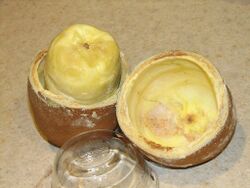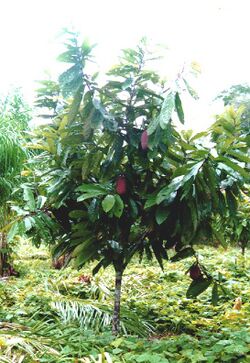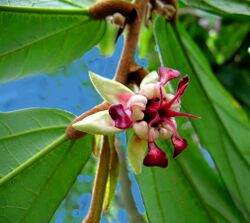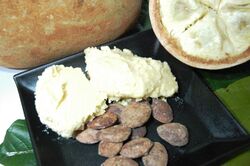Biology:Cupuaçu
| Cupuaçu | |
|---|---|

| |
| Scientific classification Error creating thumbnail: Unable to save thumbnail to destination
| |
| Kingdom: | Plantae |
| Clade: | Tracheophytes |
| Clade: | Angiosperms |
| Clade: | Eudicots |
| Clade: | Rosids |
| Order: | Malvales |
| Family: | Malvaceae |
| Genus: | Theobroma |
| Species: | T. grandiflorum
|
| Binomial name | |
| Theobroma grandiflorum | |
Cupuaçu (Theobroma grandiflorum), also spelled cupuassu, cupuazú, cupu assu, and copoasu, is a tropical rainforest tree related to cacao.[1] Common throughout the Amazon basin, it is widely cultivated in the jungles of Colombia, Bolivia and Peru and in the north of Brazil , with the largest production in Pará, followed by Amazonas, Rondônia and Acre.[1] The pulp of the cupuaçu fruit is widely consumed throughout Central and South America, and is used to make ice creams, snack bars, and other value added products.[2]
Plant
Cupuaçu trees usually range from 5–15 m (16–49 ft) in height, though some can reach 20 m (66 ft). They have brown bark, and the leaves range from 25–35 cm (9.8–13.8 in) long and 6–10 cm (2.4–3.9 in) across, with 9 or 10 pairs of veins. As they mature, the leaves change from pink-tinted to green, and eventually they begin bearing fruit.
Flower
Flowers of cupuaçu are structurally complex, and require pollination from biotic vectors.[3] The majority of cupuaçu trees are self-incompatible, which can result in decreased pollination levels, and consequently, a decrease in fruit yields.[3] Pollination can also be negatively affected by environmental conditions. Pollinators, which include chrysomelid weevils and stingless bees, are unable to fly between flowers in heavy rains.[3]
Fruit
The white pulp of the cupuaçu has an odour described as a mix of chocolate and pineapple and is frequently used in desserts, juices and sweets.[1] The juice tastes primarily like a pear, with a hint of banana.
Cupuaçu is generally harvested from the ground once they have naturally fallen from the tree. It can be difficult to determine peak ripeness because there is no noticeable external color change in the fruit. However studies have shown that in Western Colombian Amazon conditions, fruits generally reach full maturity within 117 days after fruit set.[4]
Cultivation
Cupuaçu is most commonly propagated from seed, but grafting and rooted cuttings are also used.[5]
Cupuaçu trees are often incorporated in agroforestry systems throughout the Amazon due to their high tolerance of infertile soils, which are predominate in the Amazon region.[5]
Pests and diseases
Witches broom (Moniliophthora perniciosa)is the most prominent disease that affects cupuaçu trees.[6] It impacts the entire tree and can result in significant loss of yields, as well as tree death if left untreated. Regular pruning is recommended to reduce the severity of this disease in cupuaçu plantings.[6]
Cupuaçu supports the butterfly herbivore, "lagarta verde", Macrosoma tipulata (Hedylidae), which can be a defoliator.[7]
Phytochemicals
Cupuaçu flavors derive from its phytochemicals, such as tannins, glycosides, theograndins, catechins, quercetin, kaempferol and isoscutellarein.[8] It also contains caffeine, theobromine, and theophylline as found in cacao, although with much lower content of caffeine.[9]
Cupuaçu butter
Cupuaçu butter is a triglyceride composed of saturated and unsaturated fatty acids, giving the butter a low melting point (approximately 30 °C) and texture of a soft solid, lending its use as a confectionery resembling white chocolate.[1] Main fatty acid components of cupuaçu butter are stearic acid (38%), oleic acid (38%), palmitic acid (11%) and arachidic acid (7%).[10]
See also
- Amazonian cuisine
References
- ↑ 1.0 1.1 1.2 1.3 Giacometti DC (1998). "Cupuaçu. In: Neglected Crops: 1492 from a Different Perspective, J.E. Hernándo Bermejo and J. León (eds.). Plant Production and Protection Series No. 26. FAO, Rome, Italy. p. 205-209.". Center for New Crops & Plant Products, Purdue University, Department of Horticulture and Landscape Architecture, W. Lafayette, IN, USA. http://www.hort.purdue.edu/newcrop/1492/cupuacu.html.
- ↑ Prazeres, Isadora (2017). "Elaboration and characterization of snack bars made with ingredients from the Amazon". Acta Amazonica 47: 103–110.
- ↑ 3.0 3.1 3.2 Venturieri, Giorgini (2010). "Flowering levels, harvest season and yields of Cupuassu (Theobroma grandiflorum).". Acta Amazonica.
- ↑ Hernandez, Claudia (March 1, 2012). "Growth and development of the cupuacu fruit (Theobroma grandiflorum [Wiild. Ex Spreng.] Schum.) in the western colombian Amazon". Agronomia Colombiana 30: 95–102.
- ↑ 5.0 5.1 Schroth, G. (2000). "Growth, Yield and Mineral Nutrition of Cupuacu (Theobroma grandiflorum) in Two Multi-Strata Agroforestry Systems on a Ferralitic Amazonian Upland Soil at Four Fertilization Levels". Journal of Applied Botany.
- ↑ 6.0 6.1 Alves, Rafael (2009). "Evolution of witch's broom disease and evaluation of resistance in Cupuassu progenies". Revista Brasileira de Fruticultura 31.
- ↑ Lourido, G.; Silva, N. M.; Motta, C. (2007). "Parâmetros Biológicos e Injúrias de Macrosoma tipulata Hübner (Lepidoptera: Hedylidae), em Cupuaçuzeiro [Theobroma grandiflorum (Wild ex Spreng Schum) no Amazonas"] (in Portuguese) (PDF). Neotropical Entomology 36 (1): 102–106. doi:10.1590/S1519-566X2007000100012. PMID 17420867. http://www.scielo.br/pdf/ne/v36n1/a12v36n1.pdf.
- ↑ Yang, H.; Protiva, P.; Cui, B.; Ma, C.; Baggett, S.; Hequet, V.; Mori, S.; Weinstein, I. B. et al. (2003). "New bioactive polyphenols from Theobroma grandiflorum ("cupuaçu")". Journal of Natural Products 66 (11): 1501–1504. doi:10.1021/np034002j. PMID 14640528.
- ↑ Lo Coco F, Lanuzza F, Micali G, Cappellano G (2007). "Determination of theobromine, theophylline, and caffeine in by-products of cupuaçu and cacao seeds by high-performance liquid chromatography". J Chromatogr Sci 45 (5): 273–5. PMID 17555636. http://chromsci.oxfordjournals.org/content/45/5/273.long.
- ↑ Cohen, K. de O. & Jackix, M. de N. H. (2009). "Características químicas e física da gordura de cupuaçu e da manteiga de cacau" (in Portuguese) (PDF). Documentos / Embrapa Cerrados (269): 1–22. http://ainfo.cnptia.embrapa.br/digital/bitstream/CPAC-2010/31579/1/doc-269.pdf.
Wikidata ☰ Q1144414 entry





